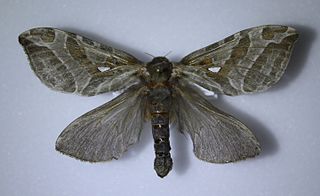
Maryland is a state in the Mid-Atlantic region, bordering Virginia, West Virginia, and the District of Columbia to its south and west; Pennsylvania to its north; and Delaware and the Atlantic Ocean to its east. The state's largest city is Baltimore, and its capital is Annapolis. Among its occasional nicknames are Old Line State, the Free State, and the Chesapeake Bay State. It is named after the English queen Henrietta Maria, known in England as Queen Mary, who was the wife of King Charles I.

Moths are a paraphyletic group of insects that includes all members of the order Lepidoptera that are not butterflies, with moths making up the vast majority of the order. There are thought to be approximately 160,000 species of moth, many of which have yet to be described. Most species of moth are nocturnal, but there are also crepuscular and diurnal species.

The Arctiinae are a large and diverse subfamily of moths, with around 11,000 species found all over the world, including 6,000 neotropical species. This group includes the groups commonly known as tiger moths, which usually have bright colours, footmen, which are usually much drabber, lichen moths, and wasp moths. Many species have "hairy" caterpillars that are popularly known as woolly bears or woolly worms. The scientific name of this subfamily refers to this hairiness. Some species within the Arctiinae have the word tussock in their common name due to people misidentifying them as members of the Lymantriinae based on the characteristics of the larvae.

The Wye Oak was the largest white oak tree in the United States and the State Tree of Maryland from 1941 until its demise in 2002. Wye Oak State Park preserves the site where the revered tree stood for more than 400 years in the town of Wye Mills, Talbot County, Maryland.
Diamondback may refer to:

Schinia, commonly called flower moths, is a large genus of moths belonging to the family Noctuidae. The genus has a Holarctic distribution with the vast majority of species being found in North America, many with a very restricted range and larval food plant.
The Maryland Department of Natural Resources (DNR) is a government agency in the state of Maryland charged with maintaining natural resources including state parks, public lands, state forests, state waterways, wildlife and recreation areas. Its headquarters are in Annapolis.

The University of Maryland, College Park is a public research university in College Park, Maryland. Founded in 1856, UMD is the flagship institution of the University System of Maryland. It is also the largest university in both the state and the Washington metropolitan area, with more than 41,000 students representing all fifty states and 123 countries, and a global alumni network of over 360,000. Its twelve schools and colleges together offer over 200 degree-granting programs, including 92 undergraduate majors, 107 master's programs, and 83 doctoral programs. UMD is a member of the Association of American Universities and competes in intercollegiate athletics as a member of the Big Ten Conference.

The Baltimore checkerspot is a North American butterfly of the family Nymphalidae. It has been the official state insect of the U.S. State of Maryland since 1973. The Baltimore checkerspot was named for the first Lord Baltimore due to its similarity of colors in the family crest. Despite the species status as Maryland state insect, the population in Maryland has faced significant decline and is currently listed by the Maryland Department of Natural Resources as "rare, threatened, and endangered" animal list.

Acronicta hamamelis, the witch hazel dagger moth or puzzling dagger moth, is a moth of the family Noctuidae. The species was first described by Achille Guenée in 1852. It is found in Canada and parts of the United States, including Maryland.

Thoreau's flower moth is a moth of the family Noctuidae. It is found in North America, including Maryland, Illinois, Kansas, Oklahoma, Arizona, Ontario and Saskatchewan.

Schinia nundina, the goldenrod flower moth, is a moth of the family Noctuidae. The species was first described by Dru Drury in 1773. It is found in North America from Minnesota to southern Ontario and Nova Scotia, south to central Florida and southern Texas. Records include Arizona, Kansas, Nebraska, New York, Maryland, Oklahoma and South Carolina.

Acronicta modica, the medium dagger moth, is a moth of the family Noctuidae. It is found from Ontario and Quebec south to Arizona and Texas. It has also been recorded from Pennsylvania, Maryland, Iowa and Wisconsin.

The common apamea is a moth of the family Noctuidae. It is found from Nova Scotia to Kentucky, and west to Kansas. It has been recorded from Ontario, New York, Pennsylvania and Maryland.

Psilocorsis quercicella is a species of moth of the family Depressariidae. It is found in the United States, including Florida, Maryland, Massachusetts and Oklahoma.

Ptichodis herbarum, the common ptichodis moth, is a moth in the family Erebidae. It is found in the United States. It has also been recorded from Jamaica.

Sthenopis argenteomaculatus, the silver-spotted ghost moth, is a species of moth of the family Hepialidae. It was described by Thaddeus William Harris in 1841, and is known in North America from Nova Scotia to Virginia and west to Minnesota.
Spilosoma latipennis, the pink-legged tiger moth, or the red-legged diacrisia, is a moth in the family Erebidae. It was described by Richard Harper Stretch in 1872. It is found in eastern North America, where it has been recorded from Georgia, Indiana, Iowa, Kansas, Kentucky, Maine, Maryland, New Brunswick, New York, North Carolina, Ohio, Ontario, Pennsylvania, South Carolina, West Virginia and Wisconsin.

Nemapogon clematella, the barred white clothes moth, is a moth of the family Tineidae. It is found in most of Europe and in North America, where it has been recorded from Maryland and North Carolina. The habitat consists of woodlands.
Ronald William Hodges, known as Ron, was an American entomologist and lepidopterist.













